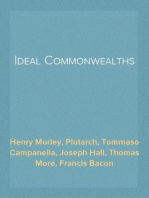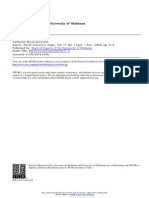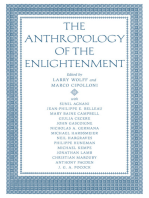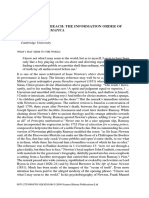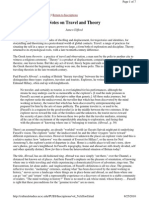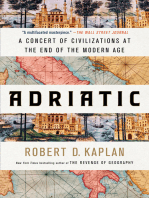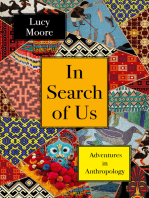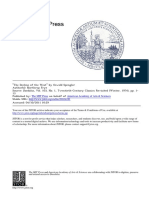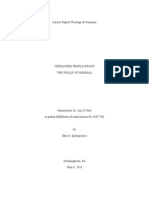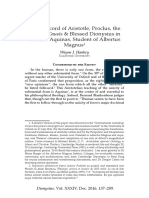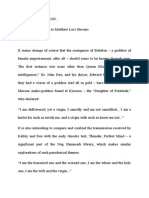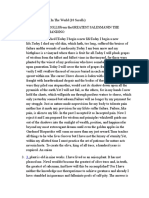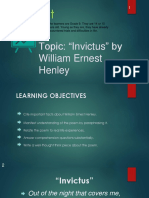No Place and New Worlds
No Place and New Worlds
Uploaded by
I-330Copyright:
Available Formats
No Place and New Worlds
No Place and New Worlds
Uploaded by
I-330Original Description:
Copyright
Available Formats
Share this document
Did you find this document useful?
Is this content inappropriate?
Copyright:
Available Formats
No Place and New Worlds
No Place and New Worlds
Uploaded by
I-330Copyright:
Available Formats
No Place and New Worlds:
The Early Modern Utopia and the Concept of the Global Community Chlo Houston
University of London, UK
Citation: Chlo Houston, No Place and New Worlds: The Early Modern Utopia and the Concept of the Global Community, Spaces of Utopia: An Electronic Journal, nr. 1, Spring 2006, pp. 13-21 <http://ler.letras.up.pt > ISSN 1646-4729.
The early modern utopia is difficult to access. Utopias from this period are reached after difficult journeys, generally by sea, involving shipwrecks and storms. When they are found, utopian countries are strange and unknown; entering a utopia always involves a process of discovery, a process which by its very nature challenges the status and the knowledge of the reader. Though written at a time which has become celebrated as the age of discovery, utopias deny that the world is wholly known. The utopia insists upon the existence of secrecy, of unknown waters and lands, and asserts that the reader is not in full possession of knowledge of the world; there exists also no-place, never before visited. So whilst the early modern utopia may usually promote itself as being a better place in a variety of ways, it always underlines the readers inferiority when it comes to understanding the world and the way in which it is laid out. It is no coincidence that the first early modern utopia appeared at the same time as true travel narratives that detailed experiences from far-off lands. Raphael Hythlodaeus, who describes the newfound land in Thomas Mores Utopia, has sailed with Amerigo Vespucci, and Utopia, published in 1516, resembles real texts printed by such sailors on their return. It was possible for the reader of travel narratives to feel a new and direct link between himself and the strange lands across the seas. As the early modern period progressed, increasingly large numbers of people were able to read firsthand accounts of those who had been to the far corners of the earth and returned to tell the tale. So, early modern utopias originate from a time when borders were being crossed and the world was opening up. However, this paper will argue that
Spaces of Utopia 1 (Spring 2006)
14
these utopias have difficulties with the idea that the world has been opened, that is, with the process of globalisation. They recognise that the world is becoming a smaller place, in that their narrators are able to attain these far-off lands, but the utopian communities themselves are usually at pains to remain closed off. So there is a paradox in early modern utopian fiction: these texts are a product of globalisation, they seem to offer information on the new communities made available to the reader by the progresses of travel and technology, but their attitude to their own borders is frequently isolationist and protective. To use an anachronism, they are globalist, in the OEDs definition, in the sense that they advocate an awareness of global issues [or] a global approach, but at the same time they are anti-global in the sense that they do not seek to foster an understanding of a global community (Oxford English Dictionary, 1989). At the rebirth of the utopian mode of writing, it is problematic for the utopia to imagine itself in any other way than in contrast to the world beyond its borders. English utopianism is born out of global exploration and its literature, yet the utopia, always defining itself by what lies outside, can never fully encompass the global community. This paper will look at four utopias written in the early seventeenth century, tracing from them two distinct approaches to this issue of how the utopia relates to the outside world. The first two texts, Tommaso Campanellas The City of the Sun, written in 1602 but not printed until 1623, and Francis Bacons New Atlantis, published posthumously in 1627, are classic examples of the isolationist utopia: careful about their borders, secretive in their dealings with the outside world. The second pair, Johann Valentin Andreaes Christianopolis, published in 1619, and Jan Amos Comeniuss The Labyrinth of the World and the Paradise of the Heart, printed in 1623, offers a different conception of the boundaries of utopia: in these texts, the utopia is difficult to access but nonetheless open to the reader. The reason for these two approaches, this paper will argue, is down to the contrasting purpose of the writers, and consequently their different use of the utopian mode of discourse. Campanella and Bacon, though they have come from dissimilar backgrounds and are ultimately using the utopian mode in quite different ways, are both advocating some degree of change in the workings of their own contemporary
Spaces of Utopia 1 (Spring 2006)
15
society. Andreae and Comenius, on the other hand, although they recognise the need for improvements to their own environments, seek first and foremost to inspire the reader to enter what they conceive of as the only ideal community available to them; the invisible community of Christianity. The difference between the two approaches is down to a fundamentally distinct conception of the nature of the ideal community: in the first pair of utopias, it is conceived of as an earthly, temporal location; in the second, the ideal society is configured along Augustinian lines, as a spiritual place, rather than a physical one.
New Atlantis is a classic example of the isolationist utopia, deeply concerned about the protection of its borders and anxious about its relationship with the outside world. The narrator and his company reach the country of Bensalem after a storm, where that are met by officials who will not allow them to approach beyond a certain distance. These officials, when they board the visitors ship, carry with them strange fruits to ward off contamination; they allow the company to enter their country, but under strict conditions, and keep them in special quarters. The visitors are held in quarantine for three days, and thereafter not allowed to stray further than a prescribed distance from the city walls (Bacon 2002: 457-462). Bensalem itself is a secretive place; particularly in the workings of its central institution, Salomons House, which has as its purpose the knowledge of Causes, and secret motions of things (idem, 480). The policy of secrecy is practised in its relationship with the outside world. The Bensalemites have a series of ambassadors, who travel around the world undercover, gaining knowledge about other countries. The admission of strangers to this society is so rare that the narrator and his company are the first to have landed in thirty-seven years, despite the increased levels of international travel in the early seventeenth century (idem, 462). Contrary to contemporary belief, however, the Bensalemites maintain that world travel is not in fact burgeoning, but rather has decreased considerably. Three thousand years ago, the Bensalemites report, the navigation of the world (specially for remote voyages) was greater than at this day (idem, 467). Following a second
Spaces of Utopia 1 (Spring 2006)
16
flood, which Bensalem survived, but which nearly destroyed the population of neighbouring America, international travel greatly diminished, so that few ships now reach Bensalemite shores (idem, 469). So whilst the travellers, and indeed the contemporary reader, may feel themselves to be part of an age of discovery, the Bensalemites view is quite the opposite. New Atlantis is presented as the home of an older and wiser culture, absolutely in command of its dealings with the outside world. Bacons utopia is difficult to find out about, difficult to reach and difficult to enter; in possession of the globes secrets, it keeps the rest of the world at arms length. In this it has much in common with Campanellas The City of the Sun. Campanella wrote The City of the Sun whilst in prison, following his involvement in an attempted revolt against Spanish and Church authorities in southern Italy. His ideal city is protected from the outside world by a series of walls and fortifications, so strong that they seem to the narrator entirely impenetrable (Campanella 1981: 29). The narrator of this utopia is a Genoese sailor, one of Columbuss crew, who, like the narrator of New Atlantis, is forced to take refuge in a strange environment (idem, 27). Like the Bensalemites, the Solarians are protective of their borders, which are guarded, and defended with violence if they come under attack (idem, 79, 83). They also operate a system of spying ambassadors, who learn secretly about the world, and help to improve their own culture, whilst not publicising themselves (idem, 36, 67). Also like the Bensalemites, the Solarians are kind to visitors, showing them around, and even allowing them to become citizens after a probationary period (idem, 83). But despite this seeming openness to strangers, they are at heart a closed society, and there is a continual emphasis on their difference to their European visitors, and their superiority. They are very much a family body, sharing familial relations, having their partners and children in common, and so whilst on one level they may seem welcoming, they do not allow outside influences, like slaves or foreigners, to corrupt the manners of the city (idem, 83). Like New Atlantis, the City of the Sun has a great deal more knowledge and understanding of the world than contemporary societies. They are organised on entirely rational grounds, living by a kind of natural Christianity or right reason, although they do not have revelation.
Spaces of Utopia 1 (Spring 2006)
17
In relation to this, the text even offers a theory as to why travel is increasing and the new world is being opened up to foreign visitors. To the Hospitaler, the knight to whom the sailor is relating his tale, this is all part of a divine plan to spread Christianity throughout the globe: for this reason the Spaniards discovered the rest of the world so as to unite it all under one law, even though Columbus, your fellow Genoese, was its first discoverer. These philosophers you speak of must be elected by God to be witnesses for the truth (idem, 121). So the provinces of the new world, the knight suggests, can offer proof to Europe that Christianity really is the truest and most natural religion. Thus the text tries to make sense of globalisation as having a higher religious purpose. The City of the Sun recognises the contemporary process of globalisation, and tries to conceive of it in a rational way, but as a society, it remains protective of its privacy. What these particularly isolationist utopias share is a desire for change. Campanella, in a move that is crucial to the development of the utopian mode of writing, is using the utopia to suggest at real social improvements that he would like to see take place. The City of the Sun is intended as an inspiration to others, a force for reformation. The same motivation can be detected in Bacons New Atlantis, though on a lesser scale. Bacon is not seeking total social revolution. Rather, he is exploring the consequences of the establishment of a state-supported institution of natural knowledge, something that he advocated during his own time. Both Campanella and Bacon use the utopian form to explore the consequences of social change, but neither does so within the context of an open, inviting society; instead their utopias carefully control the extent to which external influences are allowed to infiltrate. Both of these utopias may be revolutionary, in Bacons case in the non-political understanding of that word, but they imagine their idealism in the context of an imperfect world. Utopia is, as always, found to be defining itself against what lies beyond its shores.
Spaces of Utopia 1 (Spring 2006)
18
Andreaes utopia, Christianopolis, shares the conventions of other Renaissance utopias in taking the form of a narrative reported by a traveller who happened upon foreign shores after a shipwreck (Andreae 1999: 155). But Andreae subverts the usual attempts to make the newfound land seem like a real place, giving it a nonsense geographical location, claiming to have reached it from the Academic Ocean on a ship called Fantasy (idem, 155-156). Andreae uses the idea of the journey, but his utopia is not interested in contemporary travel or the process of globalisation. Whilst Andreae employs the usual convention that the island is hard to get to, he takes pains throughout the text to emphasise that this ideal society is in fact open to anyone. In his opening letter to the reader, he directly enjoins the reader to come to Christianopolis with him; later he wishes that the reader will visit and learn more about the community firsthand (idem, 153-154, 252). After he has been examined on arrival, the narrator is welcomed into Christianopolis with open arms and told You are ours! (idem, 161). Once the narrator has been accepted, he becomes a part of this community, and when he leaves, it is only to return as soon as possible with his friends. His final leave-taking has biblical overtones: Wherever you go, there will I go too. I shall have the same people and the same God as you. Where you die, there shall I too die and there shall I be buried. And so may Jehovah be merciful to me, that only death shall separate me from you (idem, 283). The chancellor to whom this speech is made is happy at the idea that the narrator should publicise Christianopolis abroad and return with his friends to live there permanently (idem, 281-282). The primary purpose of this openness is to emphasise that Christianopolis represents a spiritual rather than a physical ideal. Andreae does suggest social improvements in his portrait of an ideal society, particularly in the field of education. However, his chief concern is not to provoke social change but to encourage the reader in devotion to the only community perceived as being universal, the invisible Christian church. Hence Andreae takes pains to liken the journey to Christianopolis to the journey to heaven, to stress that the reader may come to Christianopolis very soon, if you are good (idem, 283). This ideal society is not easy to get into, but it is unreservedly open to all. Comeniuss utopia, The Labyrinth of the World and the Paradise of the Heart, is somewhat different from the other texts here considered. In an
Spaces of Utopia 1 (Spring 2006)
19
allegorical style that was to have considerable influence on later Protestant writers such as John Bunyan, Comenius charts the experiences of a pilgrim in his hunt for a vocation. Increasingly disappointed with the horrors of the world he sees around him, the pilgrim finally wishes he could escape the world entirely (Comenius 1997: 185). Hearing a voice calling him to return to his own heart, the pilgrim closes off his ears, nose, and mouth, and retreats inside his own body (idem, 187). Within his heart he meets Christ, and is brought to understand the folly of seeking fulfilment in the world. Instead he learns that the only true vocation is a life lived for Christ, and the text ends with the pilgrim devoting himself to a truly Christian life (idem, 225). The pilgrim is ultimately offered two idealised communities or utopias: the first is the province of his own heart and soul; the second, the invisible Christian community of worshippers. But this second community does not include all those who go to church and profess themselves Christians. Instead, the entrance to the invisible community is hidden within the church itself. As in Christianopolis, all those who wish to enter this community must undergo a rigorous examination, must give up all worldly knowledge in favour of humility, but this process results in a transformation: the true church is the world turned upside down (idem, 198). The pilgrim learns that so all-encompassing is the invisible church that the true Christian does not care who rules the earthly kingdom; because it is in the outside world that the pilgrim is a tenant, and it is the inner, spiritual community to which he really belongs. So the utopian community in this text is not easy to find, because it is not a physical location and its entrance is hidden, and it is not easy to access, because its members are truly pious and godly, but its doors are open to all who are humble enough to enter. As in Christianopolis, the pilgrim becomes a member of this new community, renouncing the earthly one: Here I am, I am yours, I am your own, yours eternally (). Lead me through this mournful darkness of the world to the eternal light (idem, 224-225). This conception of the ideal society clearly takes much from the Augustinian tradition, in its insistence that the truly ideal community is spiritual, simultaneously inaccessible and open to all, and that the importance of earthly government pales in comparison.
Spaces of Utopia 1 (Spring 2006)
20
Andreae and Comenius share an ideological and cultural background, rooted in the drive for further reformation that was taking place in northern Europe during the early years of the seventeenth century. In their focus on the importance of individual over communal reformation, on knowledge of Christ as the only useful knowledge, and on the best systems and practices of education, they share the concerns and motivations of the Second Reformation. Their utopias, just as much as Campanellas, are written to effect change, but the change that they envisage begins on a personal, individual level. They seek to motivate what they perceive of as a return to the true aims and habits of Christianity. They are aware that the earthly community is flawed, and can never be perfected, that as Andreae writes in his letter to the reader, The truth is that while the world sins, it prefers to have this concealed rather than praised (Andreae 1999: 149). The aim of these utopias is to reveal the sinful activity of the world, and to encourage the reader to turn to the spiritual community instead, as this is seen as the only society that can be perfected, that can really be made ideal. As with the more isolationist utopia, the spiritual utopia defines itself by what lies outside, but unlike Bacon and Campanella, the authors of the spiritual utopia extend an invitation to the reader to join the ideal society within.
This paper has attempted to trace two divergent manifestations of the utopian mode of writing in the early seventeenth century, and has argued that the disparity between the two is brought about by the different motivations of the utopias authors. These two manifestations (utopia as political statement or blueprint and utopia as allegory or metaphor) are indicative of the ways in which the utopian mode was to be used by future generations of writers. They can also be traced back to the roots of early modern ideal-state fiction, to Thomas Mores Utopia. But in the seventeenth century, the utopia has a unique status. It has become a serious means of both expressing dissatisfaction with the status quo, and of suggesting real improvements to it. In their seriousness, in their heartfelt conviction that humanity has the power to improve itself and in their belief that utopian writings can help in that effort, the utopian authors of the
Spaces of Utopia 1 (Spring 2006)
21
early seventeenth century provide what might be called the classic utopian moment. During this crucial period of development for the utopian mode of writing, as indeed at any other period, it is impossible to read the utopian text in a vacuum. In its anxiety about its borders and reaction to the contemporary processes of global expansion in trade and travel, the utopia can be seen to be involved with the concerns of its age. Whether isolationist or open, insular or global, the early modern utopia, cultural product of the age of discovery, remains fundamentally engaged with the contemporary development of globalisation.
Works Cited
Andreae, Johann Valentin (1999), Christianopolis, ed. Edward H. Thompson, Dordrecht, Kluwer Academic Publishers.
Bacon, Francis (2002), New Atlantis, in Francis Bacon: The Major Works, ed. Brian Vickers, Oxford, Oxford UP [1996].
Campanella, Tommaso (1981), La Citta del Sole: Dialogo Poetico / The City of the Sun: A Poetical Dialogue, trans. Daniel J. Donno, Berkeley, University of California Press.
Comenius, Jan Amos (1997), The Labyrinth of the World and the Paradise of the Heart, trans. Howard Louthan and Andrea Sterk, New York, Paulist Press. Oxford English Dictionary online (1989), 2nd edition, Oxford, Oxford University Press.
You might also like
- Steiner Atlantis and LemuriaDocument43 pagesSteiner Atlantis and LemuriaNata Valle100% (10)
- How To Read Your Horoscope by Nalini KantaDocument288 pagesHow To Read Your Horoscope by Nalini Kantasenthil5n100% (1)
- The Concise Meditations of Marcus Aurelius by Robin HomerDocument19 pagesThe Concise Meditations of Marcus Aurelius by Robin HomerRobin Homer100% (14)
- New Worlds, Ancient TextsDocument16 pagesNew Worlds, Ancient TextsKevin Sedeño-GuillénNo ratings yet
- Jean Louis de Biasi Divine Arcana of Aurum Solis PDFDocument355 pagesJean Louis de Biasi Divine Arcana of Aurum Solis PDFJohn Varan83% (12)
- Colonization A Global HistoryDocument415 pagesColonization A Global HistoryRoseNo ratings yet
- The Empires of Atlantis: The Origins of Ancient Civilizations and Mystery Traditions throughout the AgesFrom EverandThe Empires of Atlantis: The Origins of Ancient Civilizations and Mystery Traditions throughout the AgesRating: 4 out of 5 stars4/5 (5)
- Atlantis and the Cycles of Time: Prophecies, Traditions, and Occult RevelationsFrom EverandAtlantis and the Cycles of Time: Prophecies, Traditions, and Occult RevelationsRating: 4 out of 5 stars4/5 (8)
- Tempest Context Handout 2018 EMDocument8 pagesTempest Context Handout 2018 EMEdmund McmahonNo ratings yet
- Christos Yannaras - Trans of Philosophie Sans RuptureDocument17 pagesChristos Yannaras - Trans of Philosophie Sans RuptureJames L. Kelley100% (1)
- (En.) Noua Atlantidă. Cetatea SoareluiDocument90 pages(En.) Noua Atlantidă. Cetatea SoareluilucianacatalinanastasescuNo ratings yet
- Nicolson, Marjorie. Cosmic VoyagesDocument26 pagesNicolson, Marjorie. Cosmic VoyagesluciananmartinezNo ratings yet
- Tempest ThemesDocument12 pagesTempest Themesc28rm2No ratings yet
- The New AtlantisDocument2 pagesThe New Atlantisalmeidaai82No ratings yet
- A. Connections Between The Renaissance and The Victorian AgeDocument6 pagesA. Connections Between The Renaissance and The Victorian AgeAndreeaMirunaNo ratings yet
- 152 PDFDocument8 pages152 PDFastroNo ratings yet
- Units 5-6Document6 pagesUnits 5-6NicoletaIonNo ratings yet
- Digest 2018 Mystical ItalyDocument40 pagesDigest 2018 Mystical ItalyFrancisco CanalliNo ratings yet
- Dreams of Other Worlds: The Amazing Story of Unmanned Space Exploration - Revised and Updated EditionFrom EverandDreams of Other Worlds: The Amazing Story of Unmanned Space Exploration - Revised and Updated EditionRating: 4 out of 5 stars4/5 (4)
- Strangers Nowhere in the World: The Rise of Cosmopolitanism in Early Modern EuropeFrom EverandStrangers Nowhere in the World: The Rise of Cosmopolitanism in Early Modern EuropeNo ratings yet
- Frankenstein in Baghdad - A Contemporary Iraqi DystopianDocument10 pagesFrankenstein in Baghdad - A Contemporary Iraqi DystopianButhaina Saadoon GhanimNo ratings yet
- A Short History of Utopian Studies.2009Document12 pagesA Short History of Utopian Studies.2009Dobriša CesarićNo ratings yet
- The Triumph of Human Empire: Verne, Morris, and Stevenson at the End of the WorldFrom EverandThe Triumph of Human Empire: Verne, Morris, and Stevenson at the End of the WorldNo ratings yet
- Michael Collots Pour Une Geographie LittDocument3 pagesMichael Collots Pour Une Geographie LittArgiris KaravouliasNo ratings yet
- Thomas MoreDocument11 pagesThomas Moresarawathi a/p muniandyNo ratings yet
- Alien Life Imagined Communicating The Science and Culture of Astrobiology (Mark Brake) (Z-Library)Document283 pagesAlien Life Imagined Communicating The Science and Culture of Astrobiology (Mark Brake) (Z-Library)CANASTA ZOE D.No ratings yet
- Kant in the Land of Extraterrestrials: Cosmopolitical PhilosofictionsFrom EverandKant in the Land of Extraterrestrials: Cosmopolitical PhilosofictionsRating: 1.5 out of 5 stars1.5/5 (1)
- Damrosch 2003 - What Is World LiteratureDocument7 pagesDamrosch 2003 - What Is World LiteratureblablismoNo ratings yet
- Transworld Underground Casanova S IcosaDocument7 pagesTransworld Underground Casanova S IcosaDidier CosteNo ratings yet
- APPELBAUM, Robert. Utopia and Utopianism PDFDocument16 pagesAPPELBAUM, Robert. Utopia and Utopianism PDFLucía Dapena BarbaNo ratings yet
- 4-Schaffer - Newton On The BeachDocument34 pages4-Schaffer - Newton On The Beachruben_nahuiNo ratings yet
- Goodey - Mapping Utopia - Geographical Review 1970Document17 pagesGoodey - Mapping Utopia - Geographical Review 1970Tae-Yeoun Keum100% (1)
- Niccolò Machiavelli: An Intellectual BiographyFrom EverandNiccolò Machiavelli: An Intellectual BiographyRating: 4 out of 5 stars4/5 (4)
- Part I - Renaissance To EnlightenmentDocument5 pagesPart I - Renaissance To Enlightenmentnicole arriesgadoNo ratings yet
- Middle Ages and MexicoDocument13 pagesMiddle Ages and Mexicolector1992No ratings yet
- Kraus ChapterDocument37 pagesKraus ChapterRachel O'ReillyNo ratings yet
- This Earthly Globe: A Venetian Geographer and the Quest to Map the WorldFrom EverandThis Earthly Globe: A Venetian Geographer and the Quest to Map the WorldRating: 4.5 out of 5 stars4.5/5 (4)
- Australia as the Antipodal Utopia: European Imaginations From Antiquity to the Nineteenth CenturyFrom EverandAustralia as the Antipodal Utopia: European Imaginations From Antiquity to the Nineteenth CenturyNo ratings yet
- Wine, Women, and Song Mediaeval Latin Students' songs; Now first translated into English verseFrom EverandWine, Women, and Song Mediaeval Latin Students' songs; Now first translated into English verseRating: 5 out of 5 stars5/5 (1)
- Telescope and ImaginationDocument29 pagesTelescope and ImaginationJabłkowyBałwanekNo ratings yet
- The Original SubalternDocument11 pagesThe Original SubalternBob MaestasNo ratings yet
- Clifford - Notes On Travel and Theory (Complit - Utoronto.ca)Document7 pagesClifford - Notes On Travel and Theory (Complit - Utoronto.ca)Johir UddinNo ratings yet
- Origins of National Consciousness: Anderson, BenedictDocument7 pagesOrigins of National Consciousness: Anderson, Benedictsvh5m7gn8fNo ratings yet
- Acceptance-speech-by-Dipesh-Chakrabarty_European-Essay-PrizeDocument10 pagesAcceptance-speech-by-Dipesh-Chakrabarty_European-Essay-Prizedzfjrj2d9qNo ratings yet
- Far Afield: French Anthropology between Science and LiteratureFrom EverandFar Afield: French Anthropology between Science and LiteratureNo ratings yet
- Tema 2 - Exercicios-1Document7 pagesTema 2 - Exercicios-1alugrisNo ratings yet
- The Glory of the Lord: A Theological AestheticsFrom EverandThe Glory of the Lord: A Theological AestheticsRating: 4 out of 5 stars4/5 (5)
- TalvetDocument15 pagesTalvetCatrinel TimisNo ratings yet
- Clifford James - Notes On Travel and TheoryDocument9 pagesClifford James - Notes On Travel and TheoryManuela Cayetana100% (1)
- Adriatic: A Concert of Civilizations at the End of the Modern AgeFrom EverandAdriatic: A Concert of Civilizations at the End of the Modern AgeRating: 4 out of 5 stars4/5 (21)
- A Brieft History of Sci-FiDocument17 pagesA Brieft History of Sci-FiIcha SarahNo ratings yet
- The Decline of The West, Oswald Spengler PDFDocument14 pagesThe Decline of The West, Oswald Spengler PDFJoe HinderbergenNo ratings yet
- Acceptance-speech-by-Dipesh-Chakrabarty_European-Essay-PrizeDocument10 pagesAcceptance-speech-by-Dipesh-Chakrabarty_European-Essay-Prizedzfjrj2d9qNo ratings yet
- Philo Quiz 5Document2 pagesPhilo Quiz 5jeffrey yumangNo ratings yet
- The Wolof of SenegalDocument23 pagesThe Wolof of SenegalspeliopoulosNo ratings yet
- Detailed Lesson Plan in 21 Century Literature From The Philippines and The WorldDocument8 pagesDetailed Lesson Plan in 21 Century Literature From The Philippines and The WorldGerishNillasGee100% (2)
- Ssi ¡Mew: Vicar Rev. Fr. Joy Alappatt Assistant VicarDocument8 pagesSsi ¡Mew: Vicar Rev. Fr. Joy Alappatt Assistant VicarsmchicagoNo ratings yet
- Beyond AscensionDocument313 pagesBeyond Ascensionelizafati100% (4)
- 5Document73 pages5Mark FrancisNo ratings yet
- WMI 2023 Prelim ID Results G10 PDFDocument7 pagesWMI 2023 Prelim ID Results G10 PDFYuni LoNo ratings yet
- KJV Apply The Word Study Bible, Large Print - 2 CorinthiansDocument20 pagesKJV Apply The Word Study Bible, Large Print - 2 CorinthiansThomas Nelson Bibles100% (2)
- UCSP - First Quarter Module 1Document20 pagesUCSP - First Quarter Module 1Lagenio, Khyla Shane P.No ratings yet
- Aleksandar-Molnar SPT 1 2012Document19 pagesAleksandar-Molnar SPT 1 2012Aleksandar MolnarNo ratings yet
- Science and TechnologyDocument27 pagesScience and TechnologyCarmela Alfonso100% (3)
- HoA SRDocument383 pagesHoA SRsushmakNo ratings yet
- MENSAJES DE OGUNDA OBARA para Todos Los Devotos IFA PARA EL AÑO 2011 / 2012Document18 pagesMENSAJES DE OGUNDA OBARA para Todos Los Devotos IFA PARA EL AÑO 2011 / 2012Ifagbemi Aworeni0% (2)
- General Directory For Catechesis: Congregation For The ClergyDocument184 pagesGeneral Directory For Catechesis: Congregation For The ClergySandra AnnNo ratings yet
- Masks of BabalonDocument7 pagesMasks of BabalonMatthew Levi Stevens100% (2)
- CalcidiusDocument157 pagesCalcidiusFrei Hélton PimentaNo ratings yet
- The BirthMark Dead Mens PathDocument3 pagesThe BirthMark Dead Mens PathJeremy NordstromNo ratings yet
- The Greatest Salesman in The WorldDocument20 pagesThe Greatest Salesman in The WorldHoa NguyenNo ratings yet
- Developmental Model of Intercultural Sensitivity (Oral Com Quiz)Document1 pageDevelopmental Model of Intercultural Sensitivity (Oral Com Quiz)Hero DiasNo ratings yet
- BS in Islamic Studies Prescribe Hec (4-Year)Document1 pageBS in Islamic Studies Prescribe Hec (4-Year)ArmaghanNo ratings yet
- Lit17 Ev g08 U1 Cil ST Stjo TestDocument4 pagesLit17 Ev g08 U1 Cil ST Stjo TestPier PezziniNo ratings yet
- About Trevor RhoneDocument14 pagesAbout Trevor RhoneDestiny100% (1)
- Context: Topic: "Invictus" by William Ernest HenleyDocument11 pagesContext: Topic: "Invictus" by William Ernest HenleyMa CorNo ratings yet
- Immovable JewelsDocument3 pagesImmovable JewelsJohn TarakdjianNo ratings yet
- Liturgical CelebrationsDocument2 pagesLiturgical CelebrationsFarah NoreenNo ratings yet
- Statements From SID Academics On Leaders' Qualifications 23 May 2016Document5 pagesStatements From SID Academics On Leaders' Qualifications 23 May 2016Jared Wright (Spectrum Magazine)No ratings yet


























